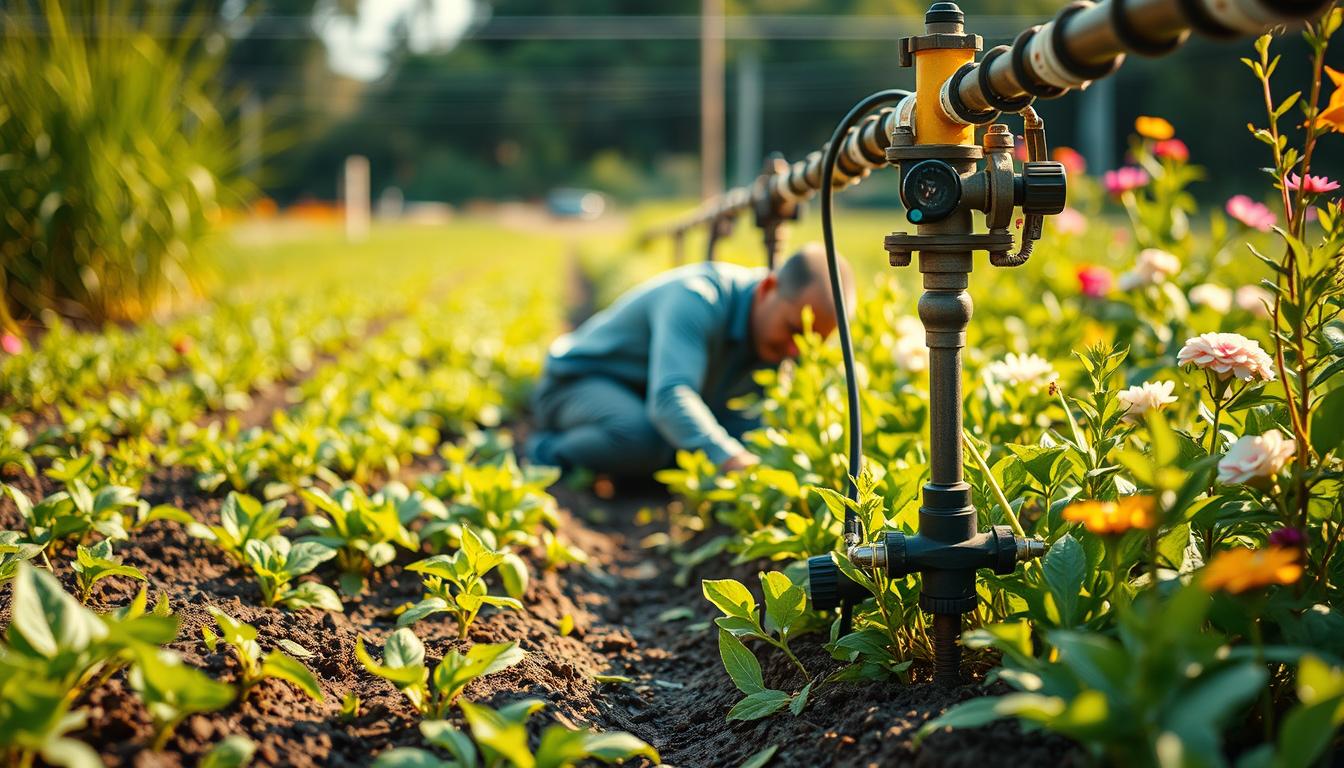Choosing smart watering methods is key in today’s gardening. A popular choice delivers water right to plant roots. This cuts down on waste and boosts growth.
This method is simple yet effective. It uses small tubes and emitters to give plants just the right amount of water. This keeps foliage dry, reducing weeds and diseases.
Water conservation is easy with these systems. They can cut water use by up to 60% compared to sprinklers. Plants grow healthier with steady moisture at their roots. This avoids the stress of drought and flooding.
These systems work for small gardens or large fields. They offer practical and environmental benefits. While setting them up takes some planning, the long-term gains are worth it for all gardeners.
The Water Crisis and Modern Gardening Challenges
Water, once thought to be endless, is now a rare resource changing how we garden today. In the U.S., gardeners must adapt due to droughts, rising water costs, and stricter use limits. This shift is not just a challenge but a moral duty for plant caretakers.
Old ways of watering, like using sprinklers or hoses, clash with today’s environmental needs. The EPA says nearly half of outdoor water is wasted due to bad irrigation. This waste happens when many areas face severe water shortages.
Gardeners must balance their desire for lush plants with saving water. We need new methods and tools that use every drop of water for plant health.
Growing Environmental Concerns
Climate change has changed how rain falls in North America. Now, we see longer dry spells and heavy rains that cause runoff. The U.S. Drought Monitor shows drought spreading from California to the Midwest.
Water reservoirs are at record lows, leading to outdoor watering limits. These rules will get stricter as more people use water.
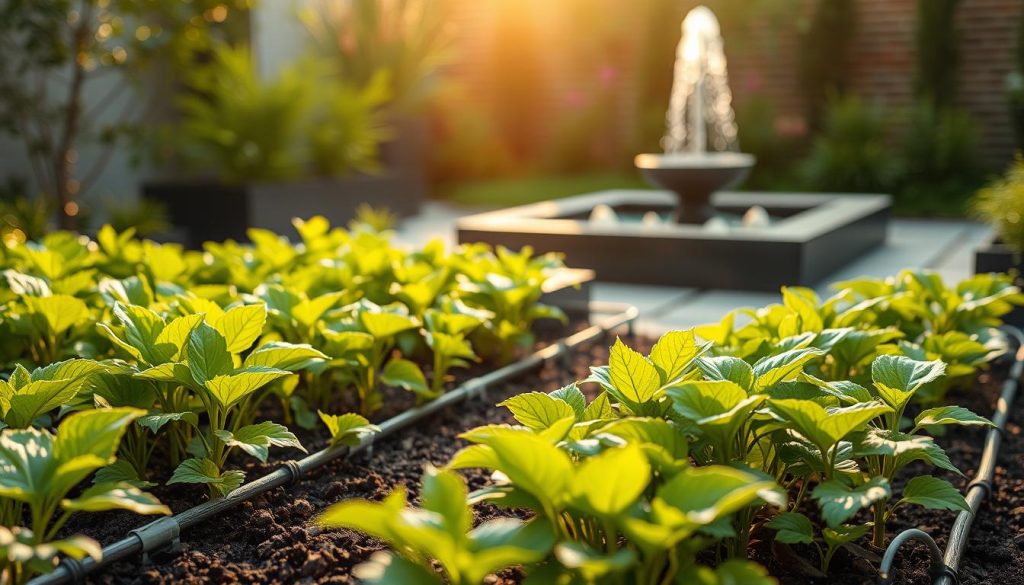
Water quality is also a big issue for gardening. Fertilizers can pollute waterways, harming the environment. Sustainable gardening must solve this problem.
Traditional Irrigation Inefficiencies
Old watering methods waste water in many ways. Sprinklers can lose up to 30% of water on windy days. Water that doesn’t soak into the soil becomes runoff, harming plants and soil.
Hose watering seems better but can be uneven. Some plants get too much water, while others get too little. This stress makes plants less drought-resistant.
Studies show that traditional watering only reaches 50-70% of plant roots. The rest evaporates or runs off. This means higher water bills and less productive gardens.
| Watering Method | Water Efficiency Rate | Common Water Loss Causes | Environmental Impact | Cost Effectiveness |
|---|---|---|---|---|
| Sprinkler Systems | 50-70% | Evaporation, wind drift, runoff | High water waste, potential erosion | Low |
| Manual Hose Watering | 60-75% | Uneven distribution, over-watering | Moderate waste, nutrient leaching | Medium |
| Flood Irrigation | 40-50% | Excessive runoff, deep percolation | Severe erosion, nutrient loss | Very Low |
| Drip Irrigation | 90-95% | Minimal evaporation, targeted delivery | Low waste, reduced runoff | High |
Old watering methods waste water and harm the environment. Over-watering leads to diseases and weeds, needing more chemicals. This cycle increases environmental harm and garden costs.
As water becomes more valuable, old ways of watering are unsustainable. Modern gardeners need efficient ways to water plants, saving water and promoting growth.
What Are Drip Irrigation Systems?
Drip irrigation systems are advanced watering systems that give water drop by drop to plants. They use a network of tubes and drippers to water plants directly at their roots. This method is very efficient, saving water and helping plants grow better.
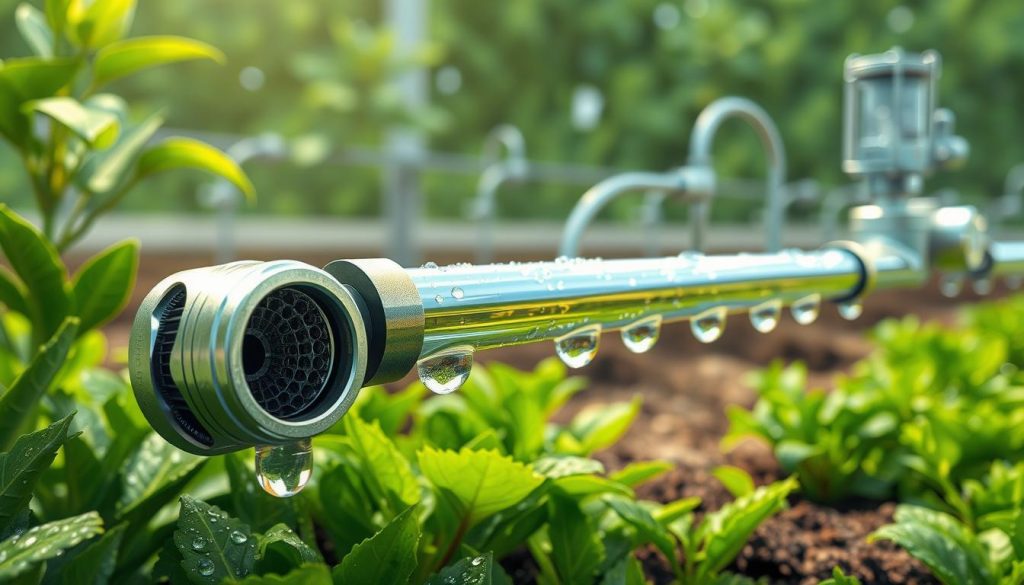
Historical Development and Evolution
Drip irrigation has been around for thousands of years. Ancient farmers in China and Egypt used clay pots to slowly water plants. This early method helped water soak into the soil.
In the 1960s, Israeli engineer Simcha Blass created the first plastic drip irrigation system. He noticed a tree growing well near a leaky pipe. This led to the first drip irrigation systems.
Since then, drip irrigation has improved a lot. New materials and smart technology have made these systems better for homes and farms.
How They Differ From Conventional Methods
Drip irrigation is different from sprinkler systems. It waters plants right at their roots. This cuts down on water lost to evaporation and runoff.
Older irrigation methods can lose up to 50% of water. But drip systems can save up to 90% of water. They water plants just right, keeping the soil moist.
Drip irrigation also keeps soil moisture steady. This is better than the wet and dry cycles of other methods. It helps plants grow stronger and healthier.
Types of Drip Irrigation Systems
Surface drip irrigation is the most common. It has tubes and emitters on the soil. It’s easy to set up and care for, great for gardens and small farms.
Subsurface drip irrigation (SDI) goes under the ground. It’s more efficient and safer from damage. But, it needs more planning to install.
Micro-sprinklers mix drip and sprinkler irrigation. They spray water over a small area. Soaker hoses are the simplest, with water seeping through the hose. They’re perfect for rows and beds.
Key Benefits of Drip Irrigation
Modern gardeners and farmers are finding drip irrigation to be a game-changer. It’s a big step forward in watering plants, saving water and improving plant health. It also means less work for you.
Water Conservation Statistics
Drip irrigation systems save a lot of water. They use 30-70% less water than old methods like sprinklers or flooding.
A study by the University of California showed gardens with drip irrigation used 60% less water than those with sprinklers. In Arizona, cotton farmers saved 50% of their water and kept their yields the same or better.
At home, gardeners can cut their water bills by 25-50% in growing seasons. This is great when water is scarce in many places in the U.S.
Improved Plant Health and Growth
Plants do well with drip irrigation’s steady moisture. It’s better than old methods that flood and then dry out.
This steady water helps plants grow strong and produce more. Tomatoes grow 15-25% more fruit with drip irrigation. Fruit trees also grow better and are more drought-resistant.
Some plants really benefit from drip irrigation:
- Vegetables like cucumbers and squash
- Berries and fruit trees
- Perennial flowers
- Container plants
Weed and Disease Reduction
Drip irrigation also fights weeds and diseases. It waters plants right at their roots, keeping the soil dry around them.
Studies show up to 70% fewer weeds in drip-irrigated areas. This means less weeding and more nutrients for your plants.
Disease also goes down with drip irrigation. It keeps plants dry, preventing diseases like powdery mildew. Strawberry growers see up to 90% less fruit rot with drip systems.
Labor and Time Savings
Drip irrigation systems save a lot of time and effort. Once set up, they need little to no attention, freeing you from daily watering.
Gardeners spend 60-80% less time watering with drip irrigation. This is really helpful in hot summers when plants need water every day.
It also means less work on weeding and disease control. Farmers save 30-50% of their labor with drip irrigation.
And, drip systems can fertilize plants easily. This means you can give your plants exactly what they need with less effort.
Essential Components of a Drip System
A drip irrigation system needs key parts to work well. Knowing these parts helps with setup, fixing issues, and upkeep. Each part of the system works together to water your plants efficiently.
Water Sources and Pressure Regulators
There are many ways to get water for your drip system. You can use city water, rain barrels, or wells. But, the water pressure is usually too high for drip systems.
Pressure regulators fix this problem. They lower the water pressure to 25-30 PSI, which is perfect for drip systems. Without them, high pressure can damage your system and make emitters work poorly. Most homes use simple regulators that are easy to install and protect your system.
Filters and Backflow Preventers
Even clean water has particles that can clog your system. Filters catch these particles before they reach your irrigation lines. Screen filters work best for city water, while media filters are better for well or pond water.
Backflow preventers are also crucial. They stop irrigation water from going back into your drinking water. These valves are needed by law and keep your water safe. Always include them for your garden’s safety and the system’s life.
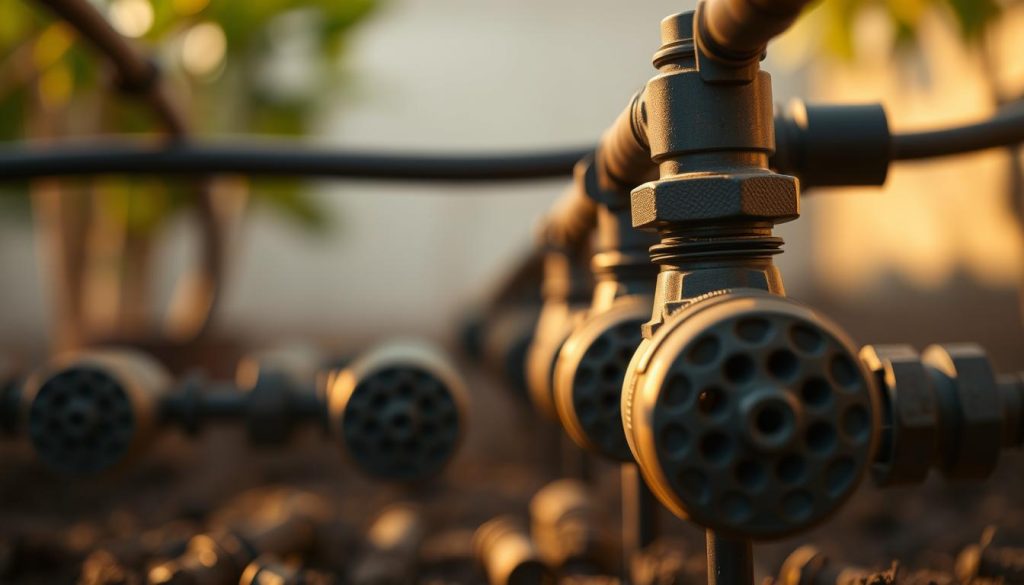
Tubing Types and Emitters
The tubing is the main part of your drip system. Mainlines carry water from the source to your garden. Then, smaller tubing delivers water to each plant.
Emitters are key for watering plants. They release water where it’s needed. Emitters come in different styles and flow rates. Spot emitters water individual plants, while in-line emitters water rows of plants.
There are many types of emitters for different plants:
- Pressure-compensating drippers maintain consistent flow regardless of pressure variations
- Micro-sprayers cover wider areas for ground covers or closely spaced plants
- Adjustable emitters allow you to customize flow rates from 0-10 GPH
- Drip line or soaker hose with built-in emitters for rows of plants with similar water needs
Controllers and Timers
Irrigation controllers are the smart part of your system. They automate watering schedules so you don’t have to remember. Basic timers attach to your faucet and set daily watering cycles.
Advanced controllers manage multiple zones with different schedules. They’re great for gardens with different plants. Smart controllers adjust watering based on weather, soil moisture, or even your phone. They can save up to 30% of water while keeping your plants watered right.
Planning and Installing Your Drip Irrigation System
Setting up a drip irrigation system needs careful planning and a step-by-step approach. It might seem hard at first, but breaking it down makes it easier. With the right steps, you’ll have a water-saving system for your plants for years.
Assessing Your Garden’s Needs
Start by figuring out what your garden needs. Walk around your garden and note the different plants. Vegetables, flowers, shrubs, and trees all need different amounts of water.
Think about your soil too. Sandy soils dry out fast and need more water. Clay soils hold water longer but need slower water flow to avoid runoff. Also, plants in the sun need more water than those in the shade.
Check your water’s pressure and flow rate. Most homes have 30-50 PSI. Knowing this helps you choose the right parts for your system. This step is key to a good drip irrigation system.
Designing Your System Layout
After assessing your garden, make a plan for your drip irrigation system. Draw a map of your garden, marking where plants are and paths. Group plants by water needs to save water.
Figure out how much water each area needs. This helps you decide how many emitters you need. Plan your hose networks to be efficient and avoid bends that block water flow.
Think about growing your garden in the future. Adding extra hose length now is easier than later. Include shut-off valves for easy maintenance without shutting down the whole system. A good plan saves water and covers all areas.
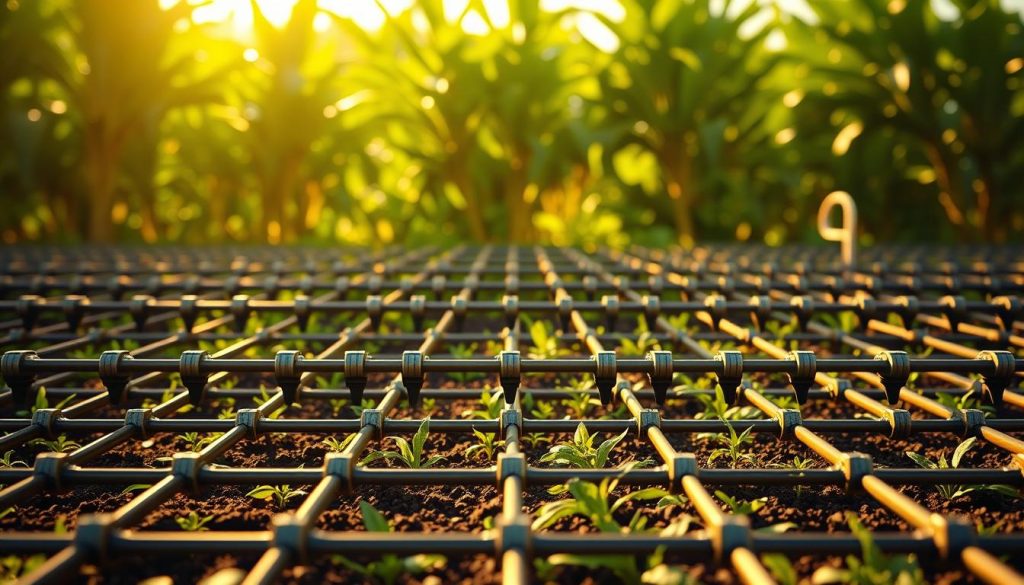
Step-by-Step Installation Guide
Once you have a plan, get all the parts you need before starting. This avoids delays. Start by connecting your system to the water source and adding a backflow preventer to keep your home water safe.
Here are the main steps:
- Put in a pressure regulator and filter at the water source to protect your system from dirt and too much pressure
- Follow your design and lay out the mainline tubing, securing it with stakes every 2-3 feet
- Make holes in the mainline for emitters, using a special tool
- Put in emitters or connect microtubing to water plants directly
- Flush the system to remove any dirt before adding the final emitters
After setting it up, test the system to make sure water is getting to the right places. Move emitters if needed and adjust pressure for even watering.
Common Installation Mistakes to Avoid
Even pros can make mistakes when setting up drip irrigation. One big error is putting emitters too far from plants. This wastes water and doesn’t help plants much. Place emitters close to roots and move them as plants grow.
Another mistake is not using a filter. Even clean water can clog emitters over time. Always use the right filters for your water.
Some people don’t calculate their system’s water needs well. This can lead to low pressure. Make sure to calculate your needs and divide your garden into zones if needed to keep pressure right.
Also, don’t put drip lines where people walk. They can be tripping hazards or get damaged. With careful planning and attention to these details, your drip irrigation system will work well for many seasons.
Maintenance and Troubleshooting
Keeping your drip irrigation system in good shape is easy but crucial. A little time each month can stop most problems. This ensures your plants get just the right amount of water. A well-kept system saves water and reduces stress during the growing season.
Seasonal Maintenance Schedule
Each season brings its own maintenance tasks for your drip irrigation system. A regular schedule helps avoid issues before they happen.
- Spring: Check all parts after winter, flush the system, and replace any damaged parts.
- Summer: Clean filters every month, check emitters, and look for sun damage on tubing.
- Fall: Clear debris from emitters, check for root damage in buried lines, and prepare for winter.
- Winter: Winterize in cold areas or water less in milder climates.
Put these tasks on your calendar for consistent upkeep. A monthly garden walk can catch problems early, keeping your plants healthy.
Identifying and Fixing Leaks
Leaks waste water and lower system pressure, hurting your garden’s water efficiency. Common leak spots are connections, damaged emitters, and punctured lines.
To spot leaks, run your system and look for wet spots or spouting water. Most fixes need simple tools like a punch tool, new fittings, and scissors. Keep a repair kit ready with spare parts for quick fixes.
Preventing and Clearing Clogs
Clogged emitters are a big issue with drip systems. Start by using the right filter at your water source. Clean it often.
To clear clogs, try these steps:
- Soak emitters in vinegar to dissolve mineral buildup
- Use a thin wire to clear debris from openings
- Flush lines by removing end caps and running water at high pressure
Winterizing Your System
In cold areas, proper winterization is key to avoid damage. Water expands when frozen, which can crack parts and cause spring headaches.
Start by turning off the water supply and removing the timer, filter, and pressure regulator. Store them indoors. Drain the main lines by opening end caps at the lowest points.
For buried parts, use compressed air to remove water. Label all parts with waterproof tags for easy reassembly in spring. Store parts in a dry, safe place to avoid damage during the off-season.
Advanced Drip Irrigation Technologies
Today’s drip irrigation technologies are a big step forward in saving water and caring for plants. They mix digital innovation with old watering methods. This creates systems that smartly respond to the environment and plant needs.
These technologies make watering more efficient and convenient for gardeners and farmers. They help save water and make gardening easier.
Smart Controllers and Weather-Based Systems
Smart controllers have changed how we manage irrigation. These WiFi-connected devices adjust watering based on weather forecasts. They stop watering when it rains and water more when it’s hot.
These controllers connect to weather stations or online data for real-time decisions. Some even calculate how much water plants need based on evapotranspiration rates.
Soil Moisture Sensors and Precision Watering
Soil moisture sensors are the next big thing in irrigation. They check moisture levels at the roots. This is different from systems that water on a fixed schedule.
These sensors can check moisture at different depths. They make sure water goes deep into the soil. This saves water and helps plants grow better.
Fertigation Methods and Benefits
Fertigation delivers liquid fertilizers through drip systems. It gives plants nutrients exactly when they need them. This is more precise than dry fertilizers.
This method cuts down on fertilizer waste and runoff. It helps plants grow faster and stronger. Gardeners save time and money too.
Automation and Remote Monitoring
Today’s technology lets you control your irrigation system from your phone or tablet. Apps give you updates on water use and system health. They alert you to any problems.
Automation goes beyond simple timers. It lets you manage different areas of your garden. For bigger places, you can control many zones from one spot. This helps you save water and improve your garden.
Whether you love technology or just want to make gardening easier, there’s a solution for you. These advanced systems combine water saving with digital tools. They make watering your garden sustainable and efficient.
Cost Considerations and ROI
Drip irrigation systems are becoming a smart choice for gardeners. They might cost a lot upfront, but they save money in the long run. Knowing the costs and benefits helps gardeners decide if these systems are right for them.
Initial Investment Breakdown
The cost of drip irrigation depends on your garden’s size. Small gardens under 500 square feet can start with DIY kits for $50-$150.
Medium gardens up to 2,000 square feet cost $200-$500. Large gardens can be $500-$2,000 or more. Professional installation adds $300-$500 but ensures a good setup.
- Basic components: Tubing ($0.15-$0.30 per foot), emitters ($0.20-$1 each), and filters ($10-$30)
- Mid-range additions: Pressure regulators ($15-$40) and basic timers ($30-$50)
- Premium options: Smart irrigation controllers ($100-$300) and moisture sensors ($30-$100)
Looking for deals? Check online retailers, garden centers during sales, and agricultural stores for bulk prices.
Long-term Water Savings
Drip irrigation cuts water bills by 30-50% compared to sprinklers. This leads to big savings.
A 1,000 square foot garden might use 600 gallons weekly with sprinklers. Drip irrigation cuts this to 300 gallons or less. This means saving 15,600 gallons a year.
At $0.005-$0.015 per gallon, this is $78-$234 saved annually. Systems pay off in 1-3 years, not counting other benefits. Smart controllers save even more by adjusting watering based on weather.
Increased Yield and Plant Value
Drip irrigation boosts plant performance. Vegetable gardens see 20-35% more yields, adding value.
Ornamental landscapes lose fewer plants, saving $100-$300 a year. This is big for water-sensitive plants.
Property values also rise with efficient irrigation. Experts say 5-12% more value for a $300,000 home. This is a $15,000-$36,000 increase.
Drip irrigation is more than eco-friendly. It’s a smart financial choice for gardeners of all sizes.
Why Every Gardener Should Consider Drip Irrigation
Water is getting scarcer, and drip irrigation is a smart choice for gardeners. It gives plants exactly what they need without wasting water. This method is good for our planet too.
Drip systems are a win-win. They can cut water use by up to 70%. Plants get the right amount of moisture, leading to stronger roots and fewer pests.
Don’t worry about setting it up being hard or expensive. Modern kits make it easy. You can set up a basic system in a weekend. The savings on water will pay for it in 1-2 seasons.
Drip irrigation works for any garden, big or small. A Seattle garden cut water use by 65% and boosted veggie yields by 30% with a drip system.
While sprinklers are good for lawns, drip irrigation is better for veggies, flowers, and trees. Many gardeners mix methods for the best results.
Using water-smart gardening now means a greener future. Your garden will grow better, and you’ll feel good about saving water. It’s a win-win for you and the planet.

